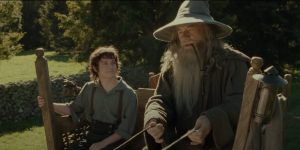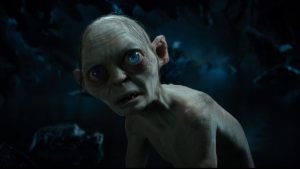2020 was nothing if not a hellish year that tested us in ways we hadn’t even thought possible back in 2019. But now, with the year finally ending and a new one about to begin, I thought it would be nice to look back and find some things that brought us in the Tolkien community just a little bit of joy and normality amidst all the chaos and confusion. Whether it was casting announcements for the upcoming Amazon series, or familiar faces reuniting for a good cause, Tolkien fans found a respite from the year’s awfulness in small, simple, pleasures that gave us each a smile and a laugh, and/or kept us at least partially sane throughout 2020.

I’ve tried to be comprehensive, but it’s been a long year, and I have forgotten much that I thought I knew. So if I’ve missed something important, be sure to tell me and I’ll happily correct my error! As I am just one Tolkien fan in a very big and very diverse fandom, these are merely my personal experiences. With that out of the way, let’s revisit some of the year’s few joyous Tolkienesque highlights.
As soon as lockdown orders went into place around the world, many of us immediately took the opportunity to crack open our old copies of J.R.R. Tolkien’s books, with the intention of returning to Middle-earth for some much-needed comfort. But actor and director Andy Serkis went further than the rest of us would or even could, reading the entirety of The Hobbit aloud in a hyped-up livestream event with the full permission of HarperCollins (for whom he then recorded a new audiobook of The Hobbit). The 12-hour long livestream was hugely successful – raising more than £283,000 for charity – and hugely satisfying for Tolkien fans, as Serkis was able to trot out his iconic Gollum voice during the character’s single, memorable sequence in the book. I myself have read The Hobbit, The Lord Of The Rings, The Silmarillion, and assorted bits of Unfinished Tales aloud to family members even prior to this quarantine, and can confirm that, while taxing on the vocal cords, it’s a truly delightful experience to partake in (I personally like to do different voices and accents for all the characters, not just the ones I’m especially good at, but, well, I’m not claiming to be a better reader-alouder than Andy Serkis…or am I?)

The rest of us social distancing stay-at-homes, unable to monetize our reading experience in quite the same way, took to social media to share the joys of Middle-earth for free with people we don’t know and who probably don’t want to have their timelines continually clogged by abnormally long Twitter threads documenting our reactions to literally every single thing in each of the books and movies. Some of us did monetize our experiences, and were forced to distort Howard Shore’s beautiful score to avoid copyright infringement. There were too many of these to count, but a few I particularly enjoyed included a first-time viewer’s twelve-part reaction to The Lord Of The Rings trilogy, artist and animator Noelle Stevenson live-tweeting the movies while enjoying a lembas bread snack, and a live-tweet of Ralph Bakshi’s cult classic The Lord Of The Rings adaptation that is perfect viewing once you hit that stage of quarantine where days are blurring together and nothing makes sense anymore, least of all reality, so you might as well just roll with the fact that, yes, Aragorn is rocking that mini-skirt.
Not wanting to let Andy Serkis have all the fun, almost the entire main cast of Peter Jackson’s The Lord Of The Rings reunited for a livestreamed event hosted by actor and comedian Josh Gad, and attended by Jackson himself as well as the trilogy’s lead screenwriter, Philippa Boyens. It was, as they say in The Shire, a party of special magnificence: gathering on their individual computer screens, the Fellowship and more teamed up for trivia, re-enactments of famous scenes, and fond reminiscences. It was all too brief, but by that point we were growing used to brief and fleeting joys, and it felt refreshingly fun. Hearing Sean Astin recite his empowering speech from the end of The Two Towers also provided us with an excuse for a good old-fashioned ugly cry, which was sweet of him.

But even as the old cast was re-assembling, a new cast was coming together in New Zealand – the one corner of the world that was, for the most part, unaffected by COVID-19. Two huge casting announcements for the upcoming Amazon Prime adaptation of J.R.R. Tolkien’s work bookended this strange year; the first in January, prior to the pandemic, and the second earlier this very month. We welcomed a number of diverse and exciting actors to Middle-earth, such as Nazanin Boniadi, Sophia Nomvete, Morfydd Clark, Peter Mullan, and Lenny Henry, and we debated endlessly about who they could be playing, here on this very blog and on fan-forums everywhere (speaking of which, the homepage of TheOneRing.com is active again as of this month, after several years). Almost a year into production on the first season, and we still don’t actually know! We’re not even sure if this is the full cast yet, or if more are still to come.
But with production on the season’s two-part pilot apparently complete and director J.A. Bayona having just departed New Zealand, it does appear that production is now underway on the rest of the season after a number of delays due to COVID that forced the entire series to halt filming throughout the spring and summer. Amazon Prime has been keeping this whole project unusually secretive, so much so that we still don’t even have an official title (which, let me tell you, is getting on my nerves). We know it takes place in the Second Age, we know a little bit about the behind-the-scenes crew, and…that’s it, mostly. In the absence of concrete information, rumors have spread like wildfire and driven some pretty controversial fandom discourse (though it gave me a chance to share my knowledge of The Mariner’s Wife with the world, so I’m not entirely unhappy about that). Thankfully, a new YouTube channel named Fellowship Of Fans has been keeping us up to date with consistently reliable news from the set, and I highly recommend you subscribe now so you don’t miss a thing.
One can hope, however, that we’ll learn more official details sooner rather than later – especially with the Tolkien Estate having announced earlier this year that a new collection of previously unpublished writings by J.R.R. Tolkien is coming in 2021, which will provide new insight into a wide variety of subjects, including the Second Age of Middle-earth, something they wryly note will be “Of particular note, given the impending Amazon series”. How much of what’s in this book, titled The Nature Of Middle-earth, will actually be new is up for debate, but I’m extremely excited for it nonetheless.

But the greatest Tolkien-related joy of 2020 (and the one in which I participated the most eagerly) has to have been the Tolkientober event: a month-long art challenge organized by Noelle Stevenson’s wife, artist and animator Molly Knox Ostertag – who, incidentally, was also recently awarded a Forbes 30 Under 30 honor. Tolkientober brought us together through the inclusive power of art, and allowed us a sneak peek of some of the next generation’s great Tolkien artists. I don’t claim to be one of those, but I did have a lot of fun sharing my works with the Tolkien community on Twitter, and it helped me rediscover my passion for drawing and sketching: something I had put aside pre-pandemic to focus on writing. Tolkientober, a casual, judgement-free, noncompetitive event aimed at spreading good vibes around the internet, taught me how to balance my talents better and renewed my confidence in my art, and for that I will always be thankful.
But enough about me. What I want to know is what your favorite moments were: so if my list is any way incomplete, share your own thoughts in the comments below and tell me about your experience as a Tolkien fan in 2020 – see you all in the new year!








